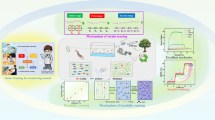Abstract
Stimuli-responsive materials with switchable wettability have promising practical applications in oil/water separation. A novel CO2-responsive cotton fabric for controlled oil/water separation was fabricated based on mussel-inspired reaction and polymerized with 2-(dimethylamino)ethyl methacrylate (DMAEMA). As expected, the modified fabric exhibited switchable hydrophilicity and hydrophobicity after CO2/N2 alternation, and it could be used for gravity-driven CO2-controlled oil/water separation. Water was selectively penetrated through the fabric and separated from oil after treating by CO2. A reversed wettability could be generated through simply treated with N2. It is expected that the as-prepared fabrics could be applied in smart oil/water separation due to the attractive properties of CO2-switchable system.










Similar content being viewed by others
References
Vahidhabanu S, Abideen Idowu A, Karuppasamy D, Ramesh Babu B, Vineetha M. Microwave initiated facile formation of sepiolite-poly(dimethylsiloxane) nanohybrid for effective removal of congo red dye from aqueous solution. ACS Sustain Chem Eng. 2017;5(11):10361–70.
Gupta P, Kandasubramanian B. Directional fluid gating by janus membranes with heterogeneous wetting properties for selective oil-water separation. ACS Appl Mater Interfaces. 2017;9(22):19102–13.
Seddighi M, Hejazi SM. Water–oil separation performance of technical textiles used for marine pollution disasters. Mar Pollut Bull. 2015;96(1):286–93.
Kota AK, Kwon G, Choi W, Mabry JM, Tuteja A. Hygro-responsive membranes for effective oil–water separation. Nature Commun. 2012;3:1025.
Kollarigowda RH, Abraham S, Montemagno CD. Antifouling cellulose hybrid biomembrane for effective oil/water separation. ACS Appl Mater Interfaces. 2017;9(35):29812–9.
Chen F, Song J, Liu Z, Liu J, Zheng H, Huang S, Sun J, Xu W, Liu X. Atmospheric pressure plasma functionalized polymer mesh: an environmentally friendly and efficient tool for oil/water separation. ACS Sustain Chem Eng. 2016;4(12):6828–37.
Hosny AY. Separating oil from oil-water emulsions by electroflotation technique. Sep Technol. 1996;6(1):9–17.
Ge J, Zhao HY, Zhu HW, Huang J, Shi LA, Yu SH. Advanced sorbents for oil-spill cleanup: recent advances and future perspectives. Adv Mater. 2016;28(47):10459–90.
Stetsyshyn Y, Raczkowska J, Lishchynskyi O, Bernasik A, Kostruba A, Harhay K, Ohar H, Marzec MM, Budkowski A. Temperature-controlled three-stage switching of wetting, morphology, and protein adsorption. ACS Appl Mater Interfaces. 2017;9(13):12035–45.
Frysali MA, Anastasiadis SH. Temperature- and/or pH-responsive surfaces with controllable wettability: from parahydrophobicity to superhydrophilicity. Langmuir. 2017;33(36):9106–14.
Wagner N, Theato P. Light-induced wettability changes on polymer surfaces. Polymer. 2014;55(16):3436–53.
Medeiros SF, Santos AM, Fessi H, Elaissari A. Stimuli-responsive magnetic particles for biomedical applications. Int J Pharm. 2011;403(1):139–61.
Che H, Huo M, Peng L, Ye Q, Guo J, Wang K, Wei Y, Yuan J. CO2-switchable drug release from magneto-polymeric nanohybrids. Polymer Chem. 2015;6(12):2319–26.
Li M, Lei L, Zhang Q, Zhu S. CO2-breathing induced reversible activation of mechanophore within microgels. Macromol Rapid Commun. 2016;37(12):957–62.
Su X, Jessop PG, Cunningham MF. Surfactant-free polymerization forming switchable latexes that can be aggregated and redispersed by CO2 removal and then readdition. Macromolecules. 2012;45(2):666–70.
Lin S, Schattling P, Theato P. Thermo- and CO2-responsive linear polymers and hydrogels as CO2 capturing materials. Sci Adv Mater. 2015;7(5):948–55.
Quek JY, Roth PJ, Evans RA, Davis TP, Lowe AB. Reversible addition-fragmentation chain transfer synthesis of amidine-based, CO2-responsive homo and AB diblock (Co) polymers comprised of histamine and their gas-triggered self-assembly in water. J Polym Sci Part A Polym Chem. 2013;51(2):394–404.
Schattling P, Pollmann I, Theato P. Synthesis of CO2-responsive polymers by post-polymerization modification. React Funct Polym. 2014;75:16–21.
Li N, Thia L, Wang X. A CO2-responsive surface with an amidine-terminated self-assembled monolayer for stimuli-induced selective adsorption. Chem Commun. 2014;50(30):4003–6.
Che H, Huo M, Peng L, Fang T, Liu N, Feng L, Wei Y, Yuan J. CO2-responsive nanofibrous membranes with switchable oil/water wettability. Angew Chem Int Ed. 2015;54(31):8934–8.
Dong L, Fan W, Tong X, Zhang H, Chen M, Zhao Y. A CO2-responsive graphene oxide/polymer composite nanofiltration membrane for water purification. J Mater Chem A. 2018;6(16):6785–91.
Lafuma A, Quéré D. Superhydrophobic states. Nat Mater. 2003;2(7):457–60.
Solomon BR, Hyder MN, Varanasi KK. Separating oil-water nanoemulsions using flux-enhanced hierarchical membranes. Sci Rep. 2014;4:5504.
Ata MS, Liu Y, Zhitomirsky I. A review of new methods of surface chemical modification, dispersion and electrophoretic deposition of metal oxide particles. RSC Adv. 2014;4(43):22716–32.
Yah WO, Xu H, Soejima H, Ma W, Lvov Y, Takahara A. Biomimetic dopamine derivative for selective polymer modification of halloysite nanotube lumen. J Am Chem Soc. 2012;134(29):12134–7.
Brzozowska AM, Parra-Velandia FJ, Quintana R, Xiaoying Z, Lee SSC, Chin-Sing L, Jańczewski D, Teo SLM, Vancso JG. Biomimicking micropatterned surfaces and their effect on marine biofouling. Langmuir. 2014;30(30):9165–75.
Panda A, Varshney P, Mohapatra SS, Kumar A. Development of liquid repellent coating on cotton fabric by simple binary silanization with excellent self-cleaning and oil-water separation properties. Carbohyd Polym. 2018;181:1052–60.
Richard E, Lakshmi RV, Aruna ST, Basu BJ. A simple cost-effective and eco-friendly wet chemical process for the fabrication of superhydrophobic cotton fabrics. Appl Surf Sci. 2013;277:302–9.
Liang L, Su M, Zheng C, Li J, Zhan H, Li X, Meng X. Fabrication of hydrophobic/oleophilic cotton fabric by mussel-inspired chemistry for oil/water separation. Fibers Polym. 2017;18(12):2307–14.
Jessop PG, Heldebrant DJ, Li X, Eckert CA, Liotta CL. Reversible nonpolar-to-polar solvent. Nature. 2005;436(7054):1102.
Liu Y, Jessop PG, Cunningham M, Eckert CA, Liotta CL. Switchable surfactants. Science. 2006;313(5789):958–60.
Acknowledgements
The authors gratefully acknowledge the financial support of the National Natural Science Foundation of China (Grant no. 51703130), Zhejiang Provincial Natural Science Foundation of China (Grant no. LY18E080018), Shaoxing Public Welfare Project (Grant no. 2017B70042), and the International Science and Technology Cooperation Project of Shaoxing University (Grant no. 2019LGGH1004).
Author information
Authors and Affiliations
Corresponding author
Ethics declarations
Conflict of interest
On behalf of all authors, the corresponding author states that there is no conflict of interest.
Electronic supplementary material
Below is the link to the electronic supplementary material.
Supplementary material 1 (MP4 6978 kb)
Rights and permissions
About this article
Cite this article
Liang, L., Dong, Y., Wang, H. et al. Smart Cotton Fabric with CO2-Responsive Wettability for Controlled Oil/Water Separation. Adv. Fiber Mater. 1, 222–230 (2019). https://doi.org/10.1007/s42765-019-00018-7
Received:
Accepted:
Published:
Issue Date:
DOI: https://doi.org/10.1007/s42765-019-00018-7




